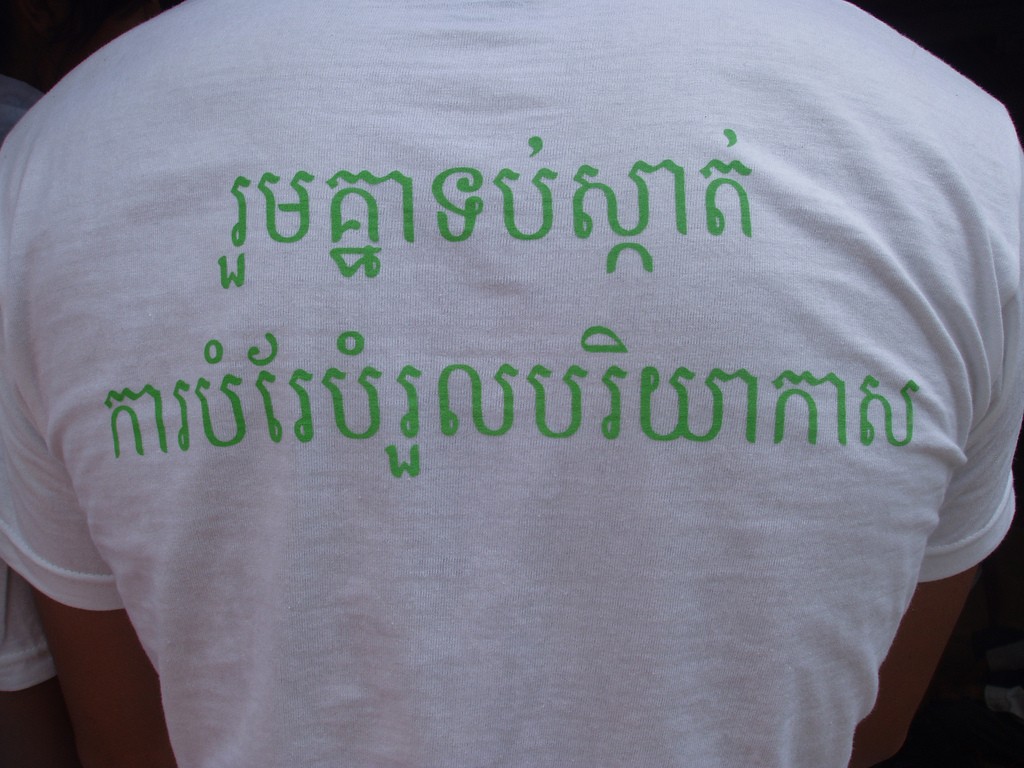
Together, fighting climate change. Photo by 350.org, taken on 12 October 2010. Licensed under CC BY-NC-SA 2.0.
Clean Development Mechanism
The Clean Development Mechanism (CDM), defined in Article 12 of the Kyoto Protocol, allows a country with an emission-reduction or emission-limitation commitment under the Kyoto Protocol to implement an emission-reduction project in developing countries. Such projects can earn saleable certified emission reduction (CER) credits, each equivalent to one ton of CO2, which can be counted towards meeting Kyoto targets.1
Registered CDM projects in Cambodia2;3
- Angkor BioCogen: this project produces 1.5 MW of electricity using rice husks at Ang Snoul district, Kandal province. The estimated GHG emission reduction is 51,620 tons of CO2 per year.
- TTY Cambodia Biogass Project: this project creates and uses renewable biogas energy at Memot district, Kampong Cham province. The estimated GHG emission reduction is 50,036 tons of CO2 per year.
- Samrong Thom Methane‐fired Power Generation: this project produces electricity to supply a pig farm using methane emitted from piggery waste at Kean Svay district, Kandal province. The estimated GHG emission reduction is 5,593 tons of CO2 per year.
- Kampot Cement Waste Heat Power Generation: the estimated GHG emission reduction is 17,107 tons of CO2 per year.
- Biogas project at MH bio-ethanol distillery: this project is implemented by MH Bio-Energy Co. Ltd. The estimated GHG emission reduction is 58,146 tons of CO2 per year.
- W2E Siang Phong Biogas: this project is implemented by W2E Siang Phong Ltd. The estimated GHG emission reduction is 26,592 tons of CO2 per year.
- Lower Stung Russei Chrum Hydroelectric project: the estimated GHG emission reduction is 701,199 tons of CO2 per year.
- Stung Atay Hydroelectric project: this project is implemented by C.H.D (Cambodia) Hydropower. The estimated GHG emission reduction is 266,472 tons of CO2 per year.
- Stung Tatay Hydroelectric project: this project is implemented by Cambodia Tatay Hydropower Ltd. The estimated GHG emission reduction is 563,074 tons of CO2 per year.
- Kamchay Hydroelectric BOT project: this project is implemented by Sinohydro Kamchay Hydroelectric Project Co. Ltd. The estimated GHG emission reduction is 281,348 tons of CO2 per year.
All proposed CDM projects must comply with Cambodia’s Law on Investment. CDM energy-related projects have to comply with the Electricity Law while the CDM afforestation and reforestation projects have to comply with the Forestry Law.
Reducing emissions from deforestation and forest degradation (REDD)
In 2011 Cambodia received funding for a full Reducing Emissions from Deforestation and Forest Degradation UN initiative (UN-REDD) country program. Before this, the country had already prepared a REDD+ Readiness Roadmap. The country program focuses on effective management of the REDD+ Readiness process and stakeholder engagement, development of the National REDD+ Strategy and Implementation framework, improved capacity to manage REDD+ at sub-national levels; and the design of a monitoring system.4
The plan aims to target companies abroad who want to offset their carbon emissions by paying Cambodia to keep its forests standing. Over 30 years, the project could potentially earn tens of millions of dollars to be split between state coffers and local communities.
Two REDD pilot projects, one in Odar Meanchay and the other one in Mondulkirri, were developed for the voluntary carbon market: The Forest Administration (FA) within MAFF was made responsible for assessing national forest carbon stocks and regulating forest carbon trading.5
The airline Virgin Atlantic buys carbon credits from the Odar Meanchay REDD+ program to help offset greenhouse gas emissions from its flights. However, a 2017 report from the UK environmental NGO Fern said that deforestation had actually sped up in the area since the project began, while villagers had not received compensation for patrolling the forest.6
Regional initiatives
Recommendations to mitigate the impacts of climate change contained in the Bangkok Call for Action were developed at the Asia-Pacific Climate Change Finance and Aid Effectiveness dialogue held on 19–20 October 2010 in Bangkok. The dialogue was facilitated by the Capacity Development for Development Effectiveness (CDDE) Facility and brought together over 75 participants representing seven governments, including Bangladesh, Cambodia, People’s Democratic Republic of Laos (PDR), Nepal, Indonesia, the Philippines and Vietnam, as well as the Pacific Islands Forum Secretariat, eight development partners and international agencies.7
Last update: 2 January 2018
References
- 1. “Clean Development Mechanism (CDM).” United Nations Framework Convention on Climate Change. http://unfccc.int/kyoto_protocol/mechanisms/clean_development_mechanism/items/2718.php.
- 2. “Market Mechanism Country Fact Sheet: Cambodia.” Institute for Global Environmental Strategies. Accessed 1 July 2015. http://pub.iges.or.jp/modules/envirolib/upload/984/attach/cambodia_final.pdf.
- 3. IGES, IGES CDM Project Database (as of 31 January 2015). Accessed 1 July 2015. http://www.iges.or.jp/en/climate-energy/mm/publication.html#03.
- 4. “Cambodia.” UN-REDD Programme. Accessed 10 September 2014. http://www.un-redd.org/AboutUNREDDProgramme/NationalProgrammes/Cambodia/tabid/6896/Default.aspx
- 5. Preparing REDD+ Readiness Roadmap in Cambodia Forestry Administration, Ministry of Agriculture Forestry and Fisheries. Regional UN-REDD Country Programme Teams Information Exchange Meeting Bangkok, 8-10 Nov, 2010. http://www.unredd.net/index.php?option=com_docman&task=cat_view&gid=2419&Itemid=53.
- 6. Yesenia Amaro 2017. “Oddar Meanchey carbon scheme used by Virgin ‘does not work'”, The Phnom Penh Post, 27 December 2017. http://www.phnompenhpost.com/national/oddar-meanchey-carbon-scheme-used-virgin-does-not-work Accessed 29 December 2017
- 7. The Bangkok Call for Action, 28 October 2010 https://www.climatefinance-developmenteffectiveness.org/sites/default/files/bangkokCallForAction.pdf

